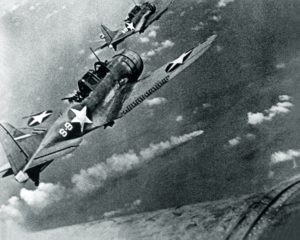I Saw the Midway Movie…and So Should You
Roland Emmerich’s long-awaited Midway opens with a clear statement that the film to follow is a true account of events.
The events of the Battle of Midway are well known. The smashing American victory was built on superior radio intelligence and crypto-analysis, of determination and courage, and a will to give battle. Emmerich’s film captures much of it, but it falls short of recounting one of the most important naval battles in world history in a way those who fought it truly deserve.
Emmerich opens Midway by setting the stage for the battle. Prewar tensions, the Pearl Harbor attack, the shocking Doolittle Raid, and the Coral Sea setback that caused Japan to realize the urgency of seeking battle to put the American carriers on the bottom, now.
Here the character of Edwin Layton is introduced. In a superb performance, actor Patrick Wilson portrays Nimitz’ Intelligence Officer as capable and prescient, which he was. Woody Harrelson delivers a matching interpretation of Admiral Chester Nimitz, and, with well-done historic accuracy, the two prepare to meet the Japanese off Midway.
The computer-generated images (CGI) that Emmerich is known for dazzle as a December 7th scene pans from the sea to the massive bow of USS Enterprise (CV-6) that steams right into the viewers lap. However, as the camera pans up further, the view becomes a flight deck covered with crew in t-shirts and shorts doing morning calisthenics, a full-motion cliché. When Midway hero and legend Lieutenant Richard Best (played by Ed Skrein) is introduced slipping his SBD Dauntless toward Enterprise, scaring his nervous radioman-gunner, pulling out just above the wake and plopping his CGI plane aboard the ship like a dog jumping into a pickup truck, knowledgeable viewers may wince.
Sadly, much of the movie may be characterized as cliché. We see tension and drama aboard ship, which is good, because it certainly exists. However, variations of the lines, “That’s a direct order!” and “I’m your superior officer!”, on the American side, are repeated more than once throughout the movie, and are distracting. In Emmerich’s defense, hokey-sounding lines like, “Here’s the man we should have listened to,” and “I’m gonna drop a bomb right down his smoke stack” were actually spoken by American officers at Pearl Harbor and Midway and are part of the historic record.
What may further grate on those familiar with the military is the robotic saluting, the atrocious appearance of the actors’ service dress khaki uniforms (certainly Hawaii and Enterprise had dry cleaning and starch in 1942), the whiny atheist Sailor, whiny and cowardly fliers (one named, a real life hero whose name is besmirched), the brusque “my-way-or-the-highway” chest-thumping of fliers discussing their manner of attack – on the American side. It reminds one of American wartime propaganda films of the period, which featured similar two-dimensional and stereotypical characters.
Emmerich’s interpretation does have its moments. Students of the battle will detect numerous tidbits of historic fact sprinkled throughout the film. The CGI is spectacular, and indispensable to bring the battle to life for today’s audiences. In his story, Washington is proven wrong, and the use of subtitles during scenes of Japanese dialogue enhance realism as they struggled with their difficult decisions that involved the realities of rearming and when to launch and recover their planes. The faces of young actors playing pilots in the ready room is a sobering reminder of the dangers our young fliers faced and the courage they displayed – repeatedly – during the battle and throughout the rest of 1942. Featuring the heroism of little-known radioman gunner Bruno Gaido, played by Nick Jonas, was refreshing.
However, CGI tracers and antiaircraft explosions filled the screen in a manner that distracted from the action. Historical accuracies – and there are many – merely flashed past the viewer while laborious scenes of overwrought dialogue in the wardroom, flight deck, and ready rooms fill long minutes of the two-hour film. The inaccuracies may be overlooked. After all, Midway is meant to entertain the movie-going public, not historians. But Emmerich claims that his film is a true account of events. If so, it failed to recount the most vital actions and dramatic dialogue of 3-7 June 1942, events that need no embellishment. Regrettably, the portrayals of Joseph Rochefort drinking on the job, of Raymond Spruance as nervous and severe, of a weak Wade McClusky, and even Richard Best’s surly arrogance amped up for gratuitous effect, do a disservice to them, their descendants, and ultimately, us.
While Midway falls short of what it could have achieved, Emmerich and Hollywood took a risk and made a film about something other than the usual fare movie audiences are fed. In that sense, the better-than-expected opening weekend box-office is encouraging, and while there is a time and place for escapism, audiences respond to historic films too. We learn through stories, and we can hope for more like this.
At the premier held at Washington’s Navy Memorial, actors Wilson and Skrein, humble to portray the men they did and honored to help tell this story to the public, conveyed their appreciation for the veterans of the battle and to those who serve today. They and all involved with the film performed their roles from the heart. At the end of his film Emmerich pays tribute to Best, Layton, McClusky, Nimitz and others. Despite its shortcomings, Midway may inspire those unfamiliar with the story to dig deeper about this fascinating battle and its meaning in world history.
Bottom line: Go see the flawed Midway with family and friends, and reward Hollywood for making a movie about naval history. Perhaps someone else will make another one.
